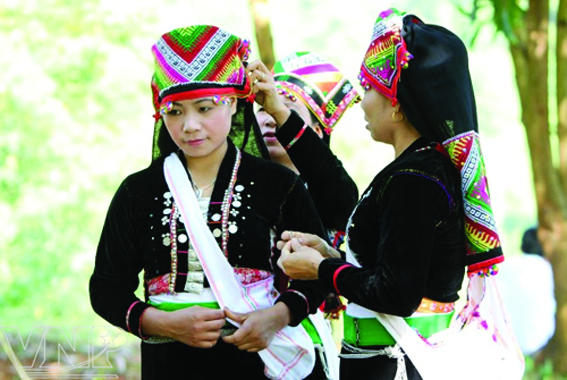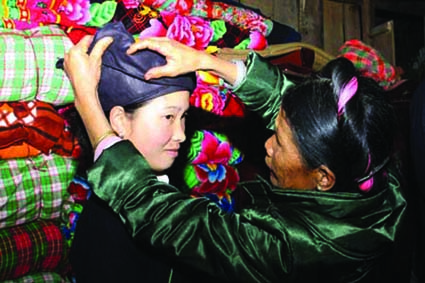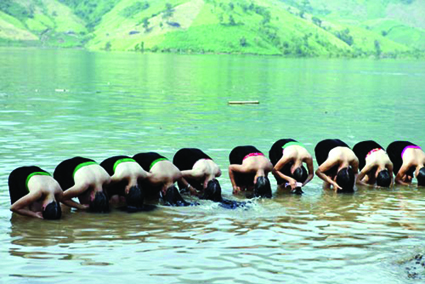>>Cham ritual dedicated to god of water
>>The “Cham” ethnic minority - its customs and practices
Ta Thi Tam
Ethnology Institute
Cham Bani people are among few ethnic groups in Vietnam which can reserve unique wedding rituals to present days.

In Cham marriage, which follows matriarchy and monogamy, women make proposal and men stay with bridal families. In a Cham family, the husband does not manage financial matters but takes charge of domestic affairs for his wife and is the main labor making wealth for the family. A married man will become an official member of his wife’s community, having the right to participate in community management. But he also maintains close contact with his mother and sisters, and even plays an important role in all affairs of his maternal clan, especially in religious matters.
A Cham wedding must be held in the third, sixth, tenth or eleventh month of the Cham calendar which correspond to July, October, February and March of the calendar year. It must also be held on an even date after the 15th and on Tuesday, Wednesday or Thursday only. This complicated but strict selection of good dates reflects the group’s matriarchy throughout the history of its culture where the feminine element always dominates.
A Cham wedding goes through three main ceremonies, namely proposal, engagement and wedding.
Proposal
According to Cham custom, although the bridal family must propose marriage, a boy is supposed to flirt a girl to win her heart before being asked to become her husband. When two lovers wish to get married, the boy will show this intention to the girl’s family which will make the proposal if accepting the boy.
To make the marriage proposal, the bridal family asks a woman matchmaker (jang klan), who is a prestigious and smooth-tongued member of the girl’s clan, to visit the boy’s family, asking for the latter’s permission for the marriage. These visits are always paid at night in a secret way. This aims to protect the honor of the girl in case the proposal is not accepted, which, once happens, will seriously hurt the reputation of the girl and her family. If the boy’s family agrees to the proposal, the two families will discuss the following steps of the wedding.
Engagement
Before the engagement ceremony, the girl’s family brings betel and areca to the boy’s, asking for permission to hold the engagement.
At the request of the bridal family, the date of engagement will be chosen by the village imam, the only person who has the authority to choose dates of important events for villagers.
Engagement offerings to the boy’s family are several traditional Cham cakes, including pei saliya (made from flour, chicken egg and peanut mixed with coconut milk), pei nung (sticky rice cake filled with green bean paste and pork), nonya (fried cake in flower shapes made from sticky rice and chicken egg), pei mang (young sticky rice cake). The offerings also include some wine and fruits like banana, mango and grapefruit, and particularly dried skate, the fish which symbolizes fertility.
The party visiting the boy’s home includes the principal matchmaker and his wife, two assistant matchmakers who carry the offerings, and the parents, maternal uncles and aunts and some close relatives of the bride. The bridal party is warmly received by the boy’s family. The two families eat cakes and drink wine while discussing preparations for the marriage. The boy’s family is then invited to be guests of the girl’s and will send a maternal uncle of the boy there to further discuss the marriage. After this visit, representatives of both families consult the village imam on the date of the wedding.
Wedding
The wedding must be held within four months after the engagement. In the past, a Cham wedding used to be held at a mosque in memory of the wedding of Ali and Fatima - the daughter of prophet Muhammad. The wedding was rather complicated and costly so only wealthy families could afford a wedding right after taking the groom to the bridal family. So, in many cases, a wedding was held only after the couple had children.

may only have talks __Photo: Internet
Today, the wedding is held at the bride’s home. One day before the wedding, the groom’s family holds a ceremony to see off its son. After attending a feast at the groom’s family, the man matchmaker and relatives escort the groom to the bridal family which has made careful preparations to receive the procession. To show respect for the groom’s party, the bride’s sends a woman standing at the gate next to a water bucket who will scoop water for members of the groom’s party to wash their hands and feet before entering the house. The groom’s party is warmly and respectfully received by the matchmaker, parents and relatives of the bride who are supposed not to displease the groom’s family. If feeling displeased, the groom’s might stop the wedding. If this happens, the bridal family must hold a ritual to admit its mistakes in order to continue with the wedding.
The groom, in a traditional white costume comprising a shirt, a sarong and a fringed turban, is led by his matchmaker to the bride’s matchmaker who will take the groom and the bride, also in a white shirt, skirt and shawl, to the bridal chamber. The matchmaker spreads out a mat on the bridal bed, asking the couple to sit on. Then a tray of offerings which includes betel, areca, lime and wine is placed in front of the couple. The matchmaker burns oil lamps, pours wine and starts praying for support from the gods and ancestors for the marriage and lifelong happiness of the newlyweds. After that, he goes out, leaving the couple in the room. The bride then feeds the groom with a piece of betel and areca, implying that from now on she will take care of him, and the groom covers his wife with his flaps, which symbolizes he will protect her for the rest of his life.
The official wedding ceremony is held by the imam the next day. An important formality of the wedding ritual is to absolve the bride and groom who are pretendedly caught by the imam to be illicitly living together. The couple is beaten by the imam and has to beg for his forgiveness by kowtowing him many times. The bride’s parents also have to plead with the imam to release their children and promise to carefully educate them. This formality is carried out in a cheerful manner.
An original wedding custom of the Cham is that the newlyweds are not supposed to bed in the first three days after their wedding when they live together in the bridal chamber. During these three days, the couple shares the bed but is separated by a tray of betel and areca and four burned oil lamps, which must be kept unmoved. This age-old custom of the Cham is believed to be originated from the Kama Sutra, an ancient Indian Hindu text which discusses the nature of love and family life. This ban on the couple is set to fan the flame of their love and their desire to live together forever.
After three days, the bride’s matchmaker conducts a ceremony to remove the betel and areca tray and pray, a symbolic act of reuniting the couple.
The couple then visits the groom’s family, bringing traditional Cham cakes, fruits and wine as presents for the groom’s parents and relatives. During this visit, the groom’s family gives wedding gifts to the newlyweds.
The Cham has the custom to fine a family which breaks its marriage pledge. Once an engagement is made, the party which cancels the marriage without a reasonable reason must compensate the other for breaking its promise. The fine is usually a pair of buffaloes but may be reduced if the family is too poor.-



